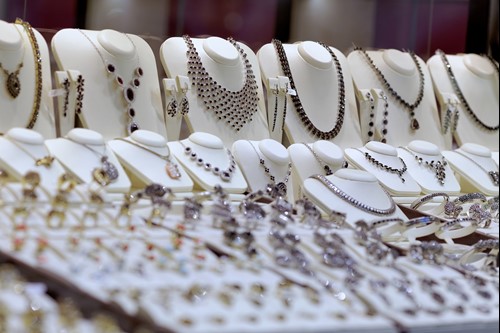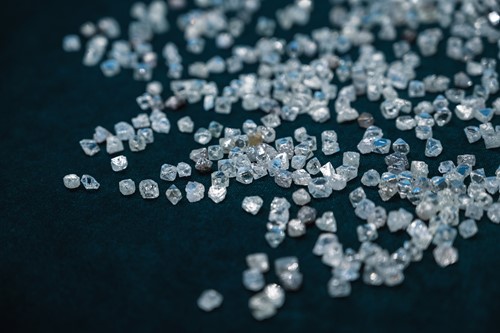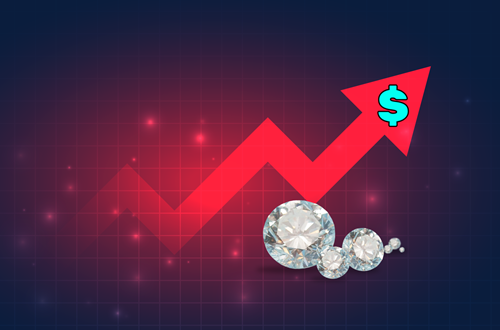Running a successful business is challenging enough - between managing inventory, keeping expenses down and managing the day to day. But being at the mercy of external and often unpredictable factors, such as inflation, that directly impact on demand, and the cost and availability of goods can be daunting.
So, we’ve put together a summary of three ways inflation is affecting the diamond and jewelry trade to give you some added insight and perspective on how rising prices may impact your business.
1. Waning Consumer Sentiment

Jewelry retailers might be noticing a drop in foot traffic as rising prices are making a dent in consumer spending, something that has become particularly noticeable in the luxury sector, where goods are not considered necessities.
The impact of inflation became even more apparent over the holiday season when Mastercard SpendingPulse revealed that US jewelry sales slipped 5.4% from the previous Christmas period between November 1 and December 24.
Many independent jewelers have expressed concern over slow October and November sales. And although foot traffic and online purchases picked up in December, some retailers have been heavily discounting products to get them to move. However, this only leads to lower revenue.
Market analyst Paul Zimnisky believes that “too hot” inflation has driven economies, primarily the US, not only to hit the brakes on pro-growth measures, but to “throw policy in reverse in an aggressive attempt to slow things down and hopefully quell the inflation problem.”

“Consumer confidence and purchasing power has been squeezed, which is resulting in less diamond jewelry sales,” he said. “This seems to be most acute at the lower-end consumer bracket.”
The Consumer Confidence Index was 102.9 in February, down from 106.0 in January, marking the second consecutive month of declines.
“The decrease reflected large drops in confidence for households aged 35 to 54 and for households earning $35,000 or more,” said Ataman Ozyildirim, senior director of economics at The Conference Board. “And while 12-month inflation expectations improved…consumers may be showing early signs of pulling back spending in the face of high prices and rising interest rates.”
Most recently, Signet Jewelers, one of the largest US jewelry retail chains, noted a falloff in its lower-priced goods, notably those under $500.
2. Trouble Maintaining Supply

The drop in consumer sentiment doesn’t only affect retailers but has repercussions throughout the pipeline. If customers are not buying jewelry, retailers are buying less polished diamonds, and manufacturers are selling less rough. This impact on the entire industry can also be attributed to supply issues.
As prices rise, many people worry about the stability of the US dollar, and trade in their cash for goods they believe are less prone to change their worth, such as gold. As more people purchase gold, its price rises, which makes it not only more expensive for jewelers to buy, but much scarcer and harder to source.

When this happens, retailers have only two recourses: use less of the material in the pieces they create, which can often be difficult, or pass the higher cost on to the customer.
3. Higher Cost of Labor and Goods

While the rising cost of gold and other manufacturing materials such as silver or platinum can add pressure to the consumer-facing portion of the industry, the higher cost of labor can disrupt business in the mining and manufacturing sectors. Companies are now being forced to either pay more to get the workers they need to perform the job, or to cut back on the number of workers they employ. Either way, they are losing money – either by paying more directly out of pocket to have the help they need, or by not having as much supply to sell for lack of workers.

In addition, inflation on crude oil, equipment and other material necessary for business operation plays a major factor in the higher price of rough diamonds. This is then passed along to the manufacturers, who charge more for polished. This makes it more difficult for cutters and polishers to afford rough goods, causing a bottleneck in the market.
“You are seeing a rather prudent slowdown in rough purchases right now,” Zimnisky noted. “Sentiment which is being passed all the way down the supply chain.”
Based on these factors, what we notice is the ripple effect of inflation throughout the entire industry. No one issue is contained to just a section of the trade, but has a waterfall affect which seeps from the mining sector to the retail end, and back again.
What Now?
So how can diamond and jewelry traders adjust in order to offset the impact of rising costs, lower consumer demand and supply shortages?
Firstly, it’s advisable to keep stock levels to a minimum so your exposure to fluctuating prices is limited and you are more cash liquid.
Additionally, when supply chains are disrupted, it’s the prime time to leverage reputable trading networks like RapNet that have a critical mass of reliable suppliers, to be able to find whatever diamonds or jewelry your customers are looking for.
Finally, step up your marketing efforts in order to combat the lower foot traffic. Trying new strategies like digital marketing and social media will help get you more exposure and keep you top of mind for any potential customers out there looking for that engagement ring or Valentine’s Day gift.


 RapNet Blog
RapNet Blog
![Diamonds 6[1][1]](/media/2120/diamonds-6-1-1.png)